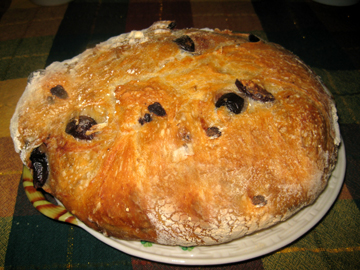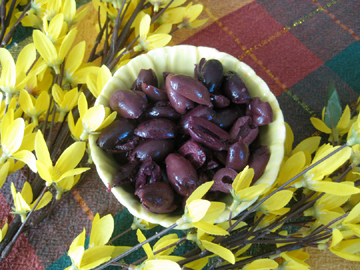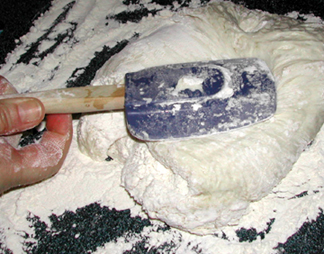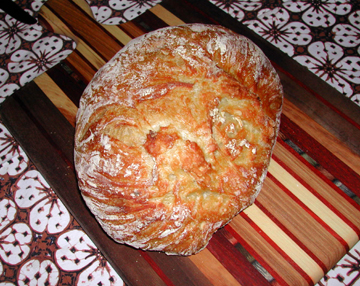
I’ve never been particularly trendy as a cook or as a person. Perhaps this is why it has taken me longer than most to jump on the “no-knead bread” bandwagon.
Many home and professional cooks ran out and made a loaf shortly after reading Mark Bittman’s ground-breaking column in The New York Times in November 2006. I have heard stories (probably apocryphal but fun nevertheless) that grocery stores ran out of rapid-rising yeast, an ingredient called for in Bittman’s formula, that day.
The recipe Bittman used came from Jim Lahey of Manhattan’s Sullivan Street Bakery. Lahey has since published My Bread: The Revolutionary No-Work, No-Knead Method.
From 2006 until 2010 I was unmoved by all this brouhaha. “So what if it doesn’t require kneading,” I thought. I don’t mind kneading bread. It’s a simple, enjoyable task that doesn’t take very long. When I’ve been writing for several hours I love the physical break kneading provides.
Two people changed my mind. One was my young friend Erin Cosby, who called this bread “the best around.” The other is my sister food blogger Abigail Blake of Sugar Apple, who wrote that her no-knead loaf was “as close to Parisian bread as [she was] going to get in the Caribbean.”
(Abigail lives on the island of Tortola in the British Virgin Islands, lucky girl that she is. I try to remind myself that she doesn’t get gorgeous foliage color in the fall, but it’s hard not to envy her a little in mud season!)
So I tried the bread. It was amazing. Note to Mark Bittman and Jim Lahey: “No-Knead Bread” is a misleading name. It should be called AWESOME Bread. Or Parisian Bread. Or Artisan Bread. Or anything that emphasizes the product rather than the process.
The bread works because it combines just a little bit of yeast and a LOT of water with the basic flour/salt mixture. It then lets them rise together for a really long time. The process concludes by baking the bread in a preheated pot in a really hot oven, which almost replicates a brick oven.
The bread emerges with a gorgeous, crispy crust and a porous texture. It shouts, “I was made in a special way!”
I’ve tried a few variations. Bittman later proposed making bread almost as good by using more yeast and letting the bread sit for less time. (You’ll note that his original recipe takes about a day.) I encourage you to try this method.
For my most recent loaf I added some nice salty Greek olives to the mixture. This is the version for which I share the recipe.
If you don’t want to use the olives, decrease the yeast to 1/3 teaspoon (1/4 teaspoon if you’re using instant yeast) and increase the salt to 1-1/2 teaspoons. (To tell you the truth, if you ARE using the olives you may omit the salt altogether; Greek olives are salty! But I love salt.)
The biggest trick to making this bread may be selecting the pan. You need a heavy pan with a volume of 4-1/2 t 5 quarts that can withstand a 450-degree oven.
Erin tells me she uses a large covered Pyrex pan. I use my mother’s old Le Creuset Dutch oven, which doesn’t have a plastic lid-grabber. (Its grabber is made of the same enameled cast iron as the rest of the pan.)
If your pot has a plastic lid-grabber, I am told that you may unscrew it and put foil in its place. (Opening the pot may be harder in this case.) Amazon.com sells Lahey’s book along with a 5-quart Lodge cast-iron Dutch oven that looks useful (and a lot less costly than my beloved Le Creuset).
One more variation: If you want to use instant or rapid-rise yeast, the water should be lukewarm instead of hot as mine was for regular yeast.
Happy baking—and eating.

Super Duper Olive Bread
Ingredients:
3 cups bread flour
1/2 teaspoon salt (optional)
3/4 teaspoon active dry yeast
3/4 cup Greek olives, drained of all brine and chopped in half vertically
1-1/2 cups hot but not boiling water
1/2 teaspoon salt (optional)
3/4 teaspoon active dry yeast
3/4 cup Greek olives, drained of all brine and chopped in half vertically
1-1/2 cups hot but not boiling water
Instructions:
The day before you want to eat your bread, combine the flour, salt, and yeast in a bowl large enough to hold more than 2 quarts of dough. Stir in the olives, followed by the water. Mix with a wooden spoon until it the dough is combined (it will be messy!), about 30 seconds.
Cover the bowl loosely and let it sit in a warm place until the dough doubles in size and bubbles form on the surface, 12 to 18 hours. Do not put the dough on a radiator (I speak from experience) as it will dry out.
Generously dust a board with flour, and using 2 wet spatulas dump the dough onto the board. Lift the edges of the dough with the spatulas into the center and nudge it into the shape of a ball.

Nudging the Bread
Dust a linen dishtowel with flour, and use the spatulas to pop the dough onto it, seam side down. If the dough is sticky (it always is, in my experience), dust the top with flour or cornmeal. Fold the ends of the dishtowel around the dough so that it is loosely covered. Allow it to rise in a warm spot for 2 hours, or until it holds the hole when you poke your finger into it.
About 1/2 hour before the second rising is complete, preheat the oven to 450 degrees. Place a covered 4-1/2- to 5-quart pot on a rack in the lower third of the oven and allow it to preheat along with the oven.
When the half hour is complete, use heavy pot holders to remove the pot from the oven and uncover it. Gently but quickly slide the bread dough into the pot, shaking the pot a little to distribute it in its ball.
Cover the pot and replace it in the oven. Bake for 30 minutes; then uncover the pot and bake for 15 to 30 minutes more, until the bread is a gorgeous brown color. Carefully remove the pot once more and use pot holders or a heat-proof spatula to remove the bread from it. Allow it to cool on a rack.
Makes 1 gorgeous, aromatic loaf.

Here is the bread without olives (but with more salt and less yeast), also fabulous.
If you enjoyed this post, please consider taking out an email subscription to my blog. Just click on the link below!
Subscribe to In Our Grandmothers’ Kitchens by Email.
Tags: Artisan Bread, Jim Lahey, Mark Bittman, No Knead Bread, Olive Bread
How perfect to begin spring with a recipe (and a further explanation) for no-knead breads. I had read Bittman’s account and thought to myself, “Someday.” That day is drawing near: the photograph alone is compelling reason to try this technique. To now have a reliable way to achieve such a gorgeous loaf of bread is the culinary equivalent of passage of the health care bill. Could you have timed this more perfectly? Thank you, Tinky! I’m off to King Arthur’s!*
*I have no yeast, no flour and no proper bread pans. We’re starting from scratch here, but we’re not kneady.
So glad you tried it Tinky! Haven’t made it in a while, will have to put it back in the repertoire. And the olives sound fantastic.
I do miss the leaves changing, and hurricane season isn’t much fun here (unless it’s only a little hurricane, in which case we break out the Pimm’s for a party). And we don’t get real maple syrup here.
Yeh….I don’t get it….. I love kneading a bit too. I love the feel of silky soft dough…
But…I also make a loaf called Tuscan Peasant Bread…that is a “no knead” variety. It’s an Artisan Bread … but, with no hot pot, seeing as I don’t have one I could use anyway. I just bake it on my baking sheet…and it’s a huge round loaf that has a lovely crisp crust. I add all sorts of different things too on occasion. The silly thing about all the no knead breads..is… the term is redundant, because they are already breads that don’t call for kneading. If you do knead them… you reduce or ruin the texture and lose the holes…. ..
I never tried ‘no knead’ bread before, but that salty olive recipe is a real temptation. I chuckled at the ‘not letting it rise on the radiator’ part, where else is there to put bread to rise?? I have the perfect old black iron pot for this, I’ll add it to my list, just have to pick up some new yeast and olives.
It sounds delicious – but I don’t think I have the patience. I very rarely bake bread these days …. and when I do I use my bread making machine (oh dear!)
Tinky, this looks amazing. Can’t wait to give it a try – very soon!
Tinky – this sounds amazing – I, too had read the Bitman and the lahey articles, but it was Artisan Bread in 5 Minutes a Day that got me to need the no-knead loaf to my life! Much the same premise, but you make a large batch of dough and stick it in the fridge, taking out a lump while you’re pre-heating the oven, just to shape it and there you are, night after night. The long slow rise was very common in the few (very few) 17th century bread recipes I work with, and similar to the bread I baked when my son was young from Laurie Colman, although hers was kneaded. Olives are on my shopping list!
I love all the different ways you all make bread. Let’s keep on baking together.
Frayed, I’d say this calls for planning rather than patience. And don’t apologize for the bread machine. I often wish I had one in the summer, when I tend not to bake for fear of getting the house too hot……. Home-made bread rules!
Oh, Tinky, I love to make bread. I’ve been using my bread maker to do the dough (I don’t like the texture of the bread baked in the machine, though, so I still bake it in the oven) due to time constraints. I simply have to try this! I’ll start it on Friday night so I can bake it on Saturday afternoon. If I leave out the olives, about how much salt and yeast should I use? If you can’t say for copyright reasons, I’ll do it with olives as you did and then tinker with it. There is nothing, nothing, nothing that compares with home baked bread – well, I can think of some things, but this is a kids show too, right? :> The photos rock!
Of course you may make it without the olives. It’s great all by itself. The first time we made it my family ate THE ENTIRE LOAF at a sitting.
Here’s the proportion:
3 cups all-purpose flour
1-1/2 teaspoons salt
1/3 teaspoon active dry yeast or 1/4 teaspoon instant (a.k.a. rapid rise) yeast
1-1/2 cups water–hot (but not boiling for active dry yeast; lukewarm for instant yeast)
Have fun, Grad!
Tinky
That looks incredible. With a glass of wine and some cheese — who needs more?
Tinky,
So glad you found my breadPots and my blog (breadbakers.blogspot.com), so I thought I would check out yours. I hadn’t been irked by the no-knead moniker, but now that you mention it… I think of it as “old world bread”. It takes no time, really, just a bit of fore thought. I make a great rye with caraway and nigella seeds. I hope you won’t wait too long for your ship to come in to try one of my pots. They mold the bread into a nice round shape, helping it to bake evenly. http://www.breadpots.weebly.com
Nice to meet you.
Judy
Judy-Your pots are gorgeous, and I hope to buy one soon (and maybe try your rye bread; I love rye bread!)……..
[…] napping at will, and having lots of hot soup, tea, and TV. I’m thinking about giving Tinky’s No-Knead Bread (a/k/a Super Duper Olive Bread, a/k/a Awesome Parisian Artisan Bread) recipe a whirl. And who […]
Hi Tinky,
This bread is delicious. The most difficult part was in planning when to begin. I finally decided to start at 7:00 p.m. Fri. and we were able to have it for dinner on Sat. The crust was indeed crispy. I found that
45 min. baking time wasn’t enough. When the bread cooled enough to cut, the middle wasn’t dry enough, so I put it back for another 15 min. Next time I’ll keep it in the pot for 1 hour. I wish I had a bread slicer to get thinner slices.
a cold March wind
reaching all the rooms
fresh bread
I was inspired.
Thanks for the recipe.
Adelaide
Adelaide–I’m honored that the bread inspired one of your poems!
I think the baking time depends on the pot and the oven and all sorts of things; let your judgment be your guide (as I’m sure it always is!).
[…] been playing about with no-knead bread, and have come up with a couple of winning variations. First, a sourdough version, which Ken has […]
I dont have an issue needing bread myself either, but this certainly is a delicious addition to the recipe files. Thank you, and feel free to try some of my recipes too!
Here we are in 2016, and I’m cooking this right now. I followed your recipe, except for salt. My only question is, when I first mixed it, it seemed dry. But I didn’t alter it. Then when I got the second rise, it didn’t… form a ball, it just kind of sprawled over the towel. I had to just plop it into the pot. However I have high hopes for some good oven spring!
Smells amazing, I must say. I can only get my oven to 425F so fingers crossed,
thanks so much,
TH
How very odd! I’ll keep my fingers crossed. It has been a while since I made this so I can’t exactly recall whether I have had this experience. My fingers are crossed for you, TH!
mid-point update: I just removed the lid and it has puffed right up and almost fills the pot! I’ll keep you posted, thanks for replying to my comment, that’s very kind. =D